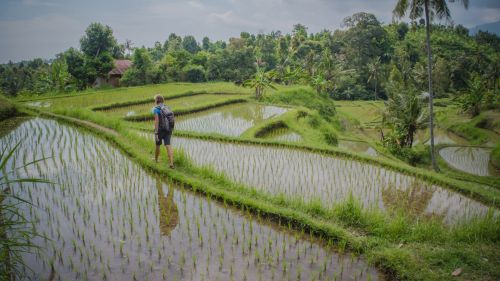Food Security Depends on Water Security—and We Need to Act Now

Better water management is crucial to global food and nutrition security.
Water Management
Obviously, irrigation is key to increasing food production and farm income and improves resilience against weather variability. But water also affects food security and nutrition through other pathways. More precise irrigation management increases not just the volume but also the diversity of food that can be produced, including dry season crops and micronutrient-rich foods such as fruits and vegetables. Improvements in the proximity and cleanliness of water sources and technologies for water extraction support women’s empowerment and well-being, saving time and improving health. Effective management of multiple uses of water and wastewater reduces exposure to fecal contamination and the risk of infectious diseases.
To contribute decisively to ending hunger, water management, policies, and investments must overcome daunting challenges. Rising global population, incomes, and urbanization are driving strong and diversified growth in food and water demand—and intensified competition for water within agriculture and across agricultural, domestic, and industrial uses. The global population is projected to reach 9.8 billion by 2050, with by far the largest growth occurring in Africa and South Asia, where food security problems are the most severe. Meanwhile, rising incomes and urbanization will increase demand for meat and more nutritious diets—and therefore more water for livestock feed, and the need for more precise water management for fruits and vegetables.
Rapid urbanization also boosts water demand for households and industry, creating competition with irrigation in important water-scarce agricultural regions. That competition can turn into outright conflict, disrupting local livelihoods and triggering migration and transborder disputes.
Developing new sources of water to alleviate competition is difficult: the cost of developing water for irrigation and other uses is increasing, as the more accessible sources have already been utilized.
Even projected increases in global production of cereals of 37 percent between 2010 and 2050, meat by 66 percent, and fruits and vegetables by 85 percent, progress on hunger and nutrition will be too slow, Water scarcity could compound this problem, further jeopardizing production growth and continued progress on hunger and nutrition.
Climate change presents another serious challenge. Climate impacts across the entire water cycle could substantially slow progress on water management, agricultural production, and food and nutrition. Increased variability in rainfall and streamflow, reduced rainfall in many dry regions, and thirstier crops due to higher temperatures will all require new policies and management to create more predictable and precise supplies of water. Sea level rise will lead to inundation and saltwater intrusion in existing irrigated and rainfed areas, putting further pressure on the land base.
Intensive groundwater pumping for irrigation has depleted aquifers in many arid and semiarid agricultural regions, leading to saltwater intrusion and declining water tables. India’s Green Revolution, for example, relied on irrigation to greatly improve productivity, but it also massively reduced groundwater reserves.
Finally, water pollution in both agricultural and non-agricultural sectors damages health and nutrition and reduces food production, constraining agricultural and economic development, especially in densely populated regions where water is already scarce and wastewater treatment is poor.
These global water security challenges are immense—as are the risks of inaction. But they can be overcome. If this vital resource is properly managed, it will be possible to meet both the food and water needs of current generations and begin building a sustainable, nourishing food system for the future.
The broad strategies outlined below can guide the design of regional and local priorities and begin to move the world toward greater food and nutrition security.
Water rights. The establishment of secure water rights is fundamental to improving water management. This means ensuring recognition of existing formal and informal rights and gender equity, to empower farmers and provide a framework for water management that is more effective and equitable. When small farmers have secure water rights, they know that they can retain access while investing in farm improvement, new crop varieties, and improved irrigation technology and crop management—all of which can change water use patterns. Physical controls on water usage, including rationing or quotas through enforcement of water rights, can maintain or reduce basin-wide water use after new technologies are introduced.
Incentives encouraging efficient water use. These include water brokering to water user associations (WUAs); paying farmers for reduced water use; and payment for environmental services to integrated soil and water management or upper watershed management that improves downstream water quality.
Reducing high subsidies for water, energy, and fertilizer use. These general support programs have caused the overuse of these resources and environmental degradation. Cutting them can encourage the adoption of conservation incentives and practices, as well as the uptake of new technologies. The money governments save should be invested in increased agricultural and water research and development to boost productivity growth; in compensatory income support to small farmers; and in carefully targeted smart subsidies to achieve specific water management goals such as initial adoption of efficient technologies. Thanks to rapidly increasing access to information and communication technologies, smart cards or phones can be used for the efficient transfer of compensatory funds to small farmers.
Reform education and extension systems. These should be overhauled to increase gender-sensitive farmer knowledge, disseminate information, and improve the adoption of appropriate existing and new water technologies. Radio, TV, social media, mobile phones, and other advanced information and communication technologies can be used to reach farmers quickly and directly. Decentralized, demand-driven, and participatory extension services with increased participation by the private sector, NGOs, WUAs, and producer organizations can engage farmers in programs whose goals coincide with their own.
Better data collection and mapping. Public-private partnerships are needed to develop satellite-based remote sensing and ground sensors to map groundwater and measure water availability and use; integrated information processing and dissemination of this information can inform real-time water and crop management decisions. In addition, increased public and private investments in infrastructure—including rural roads, cold chains, and water recycling and re-use—would reduce post-harvest losses of food and water and increase farmer incomes.
Expand small-scale irrigation. Although some potential still exists for large-scale irrigation, the emphasis should be on selective investment in farmer-led small-scale irrigation, particularly in Africa south of the Sahara. This will require targeted access to credit, weather insurance, and smart subsidies during the initial adoption stage.
Reduce international trade and macroeconomic distortions. Addressing this problem will become more urgent as climate change increases the reliance of many developing countries on food imports. As water scarcity worsens and climate variability increases, imports of food (and the virtual water embodied in that food) will be crucial in water-scarce areas to ensure food security and to facilitate short-term term imports to address food shortages caused by weather-induced production shortfalls.
Promote balanced diets for health and sustainability. This should include encouraging more responsible water use through collective action across government and business. Schools can be a platform for early nutrition education, fostering healthy eating behaviors in school meals; corporations can convey positive health messages and promote healthier sourcing and products; and health and nutrition campaigns can improve diets and nutrition by carefully targeting populations, communication activities and channels, message content, and presentation.
These policy reforms and investments will be difficult to implement and take time, political commitment, and money. Prevailing policies have strong constituencies that can be resistant to change. But overcoming these challenges will only get harder the longer they go unaddressed. The time to act on fundamental reform of water policies for food and nutrition security is now.

